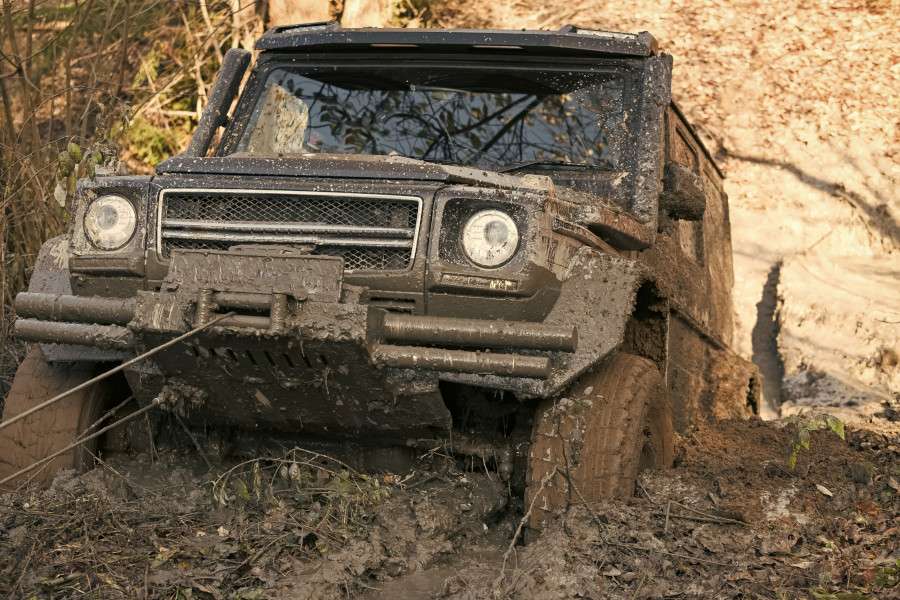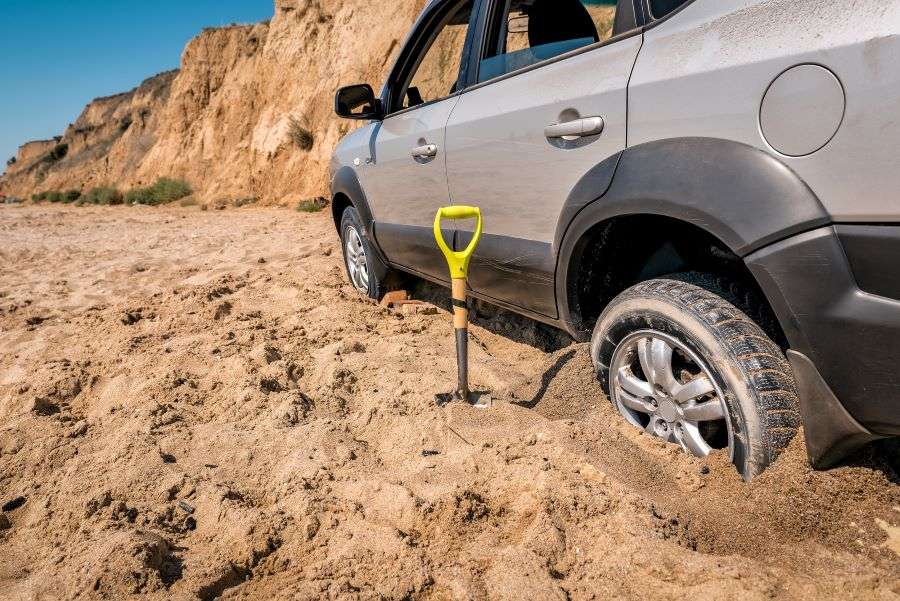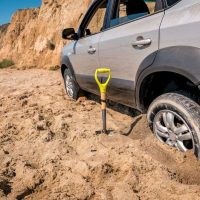Last Updated on May 16, 2023 by Paul S.
Are you finding yourself on your first 4-wheel trip? With your first trip or your 100th trip, there can be a lot of uncertainty in what you will find in the terrain you are about to explore. You can read all the info you want about the trail, but the weather is always changing it, and getting stuck or needing assistance is part of the adventure. An off road recovery gear list can make sure you are ready each and every time you hit the trail!
Whether you travel with a friend or a group or alone it is always best to be self-sufficient. Self-sufficient means that you are able to help yourself out of a sticky situation and recover your vehicle to get back home safely. To be able to recover your vehicle safely you will need the right gear. Recovery gear helps you get out of tough situations like getting stuck in the mud, snow, or sand.
The off-road recovery gear list provided below will help you not only start to collect the gear you need for going on an off-road adventure but also help you remember to pack all the gear, so you don’t forget anything! I will break the list down into sections depending on your level as you don’t need or want to buy all the gear if that isn’t applicable.
Table of Contents
Off Road Recovery Gear List
Back Road Camping: Traveling on maintained forest dirt roads and finding a camp spot close to these roads. There is no plan to do anything remotely bumpy!
- Medical Kit -recovering yourself is #1!
- Tow Strap
- Car Jack
- Gloves
- Portable Air Compressor
- Spare Tire
- Lug Wrench
- Tire Pressure Gauge
- Hitch or some type of recovery point on your vehicle
Overlanding or Trails for Stock 4wd Vehicles: Typically, these trails will be easily passable by a stock 4wd vehicle but impassable by a vehicle that doesn’t have high clearance.
- Include the items above
- Traction or Recovery Boards
- Hi-Lift Jack
- Jack Pad
- Axe
- Shovel
- Tire Repair Kit
- D-Rings
Moderate to Very Difficult Trails: These are trails where lifts and larger tires are a must, or you are very far away from getting assistance.
- Include the items above
- Winch
- Winch Extension Strap
- Tree Saver Tow Strap
- Land Anchor
It is recommended to save this list on your phone. If you are using an iPhone, you can copy and save it to your notes app or Google keep notes if you are using android. When you are ready to head back out to the trail bust this list out and start checking things off the list so that you never forget anything again! I make lists for my camping gear as well and now I have never forgotten my camping chair again!

Off Road Recovery Gear List Description
- Medical Kit: Self-explanatory. It’s definitely better to be able to help yourself first prior to helping your rig if anything should go wrong.
- Tow Strap: The tow strap should never leave your vehicle. Great for towing vehicles or getting a tow yourself.
Tow straps are best for pulling slowly and not getting speed and then coming to tension. Ensure the tow strap is always connected to an approved tow point on the vehicles otherwise there will definitely be damage!
- Car Jack: The car jack is best forchanging a tire.
- Gloves: Protect those hands!
- Portable Air Compressor: A great tool for fixing flats or airing up after you have finished the trail.
- Spare Tire: It goes with out saying to make sure you have a full-sized spare for the trail!
- Lug Wrench: Needed to change your tire.
- Tire Pressure Gauge: To check for PSI on your tires.
- Hitch Or Recovery Point: It is best to understand where your recovery points are on your vehicle prior to heading out to the trail or even on a long road trip. These points are connected to your frame and force can be applied to them. It makes them great locations for pulling a vehicle out of a stuck position.
The hitch is a great location in the rear for connecting a hitch link to be able to tie a strap to, for pulling on a vehicle.
- Traction or Recovery Boards: Traction boards provide traction when you can’t find any. Great for use in mud, snow, or sand. A shovel definitely needs to be paired with this gear.
- HI-Lift Jack: The hi-lift jack is different than the car jack as it provides a way to move your vehicle when you get stuck on something or are stuck in a rut or even as a manual winch. The Jack can lift your tire or a part of your vehicle that is connected to your frame like rock sliders or your hitch. It is recommended to get experience using your hi-lift on pavement as using these in the field can be dangerous especially if using as a winch.
While it is great at lifting things it is not recommended for changing your tire or working on your car due to not having a very sturdy base and if you lift something too high it makes it unstable.
- Jack Pad: A jack pad assists your hi-lift in supporting it on a base if you can’t find solid ground.
- Axe: Fallen trees and branches you have been warned!
- Shovel: Not only does this assist you in digging your vehicle out, assisting in laying down your traction boards, and prepping to place your hi-lift, but it also serves as a creator of the outdoor restroom!
- Tire Repair Kit: Even if you have a spare this kit could come in handy especially if you are on a longer trip. Place your spare on and then mend your tire at the next camp spot to offer peace of mind that you have a backup ready to go!
- D- Rings: D-rings are typically made of steel and provide an excellent way to connect to tow straps or winch lines to your recovery points. If ya got a Wrangler, check out our post about D rings for Wranglers!
Lock the pin in place to make sure your D-ring is secure and ensure you don’t load the D-ring from its side. Sideloading is the weakest direction but is sometimes difficult not to do.
- Winch: This is essentially a fishing reel for your car except it’s motorized! The winch is paired with a synthetic or steel line that is connected to your front bumper where you can winch other vehicles or connect yourself to a tree to get your self out of trouble.
- Winch Extension Strap: This can aid in extending the length of your winch line so that you can reach the object you are trying to connect to.
- Tree Saver Tow Strap: Save the tree you are winching to by protecting it with this strap. This strap is a lot larger which avoids biting into the tree and potentially killing it. It also helps keep your actual winch line from deteriorating from overuse.
- Land Anchor: The land anchor is great for use when there are no trees or other objects to connect to for recovery and when your friends decide to bail out on your trip! This anchor works similar to an anchor on a boat in that it digs into the ground as you start to pull it. Just ensure that no one is between you and the anchor and ensure the anchor is digging in. It might be wise to not apply the same amount of force as used when anchoring to a tree.
The fun part is getting the anchor out of the ground. Be sure to bring tools to dig it out!
Conclusion
You’re going to get stuck on the trail in some way! It is part of life on the trail. If it’s not you, it could be someone else.
The point of being on the trail is pushing yourself and your vehicle to see what it can do. Getting in thrilling situations can be addicting but getting out safely can be part of the fun as well.
Nothing is worse than being hours away from home or a store and realizing that you forgot something important. So, use this off road recovery gear list as a tool on your phone and double-check that you have everything you need for your next trail ride or adventure!
Off Road Recovery Gear List
Last Updated on May 16, 2023 by Paul S. Are you finding yourself on your first 4-wheel trip? With your first trip or your 100th trip, there can be a…


